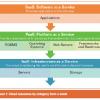|
|
Essential Methods for Agile Project Success Mark Balbes presents a framework for agile project management’s critical techniques. These techniques are required for successful agile development, where rapid requirements changes can be followed through with rapid development changes.
|
|
 |
The Agile and Scrum Mindsets: An Interview with Mitch Lacey Mitch Lacey recently took the time to speak with us ahead of his 2012 Agile Development Conference session titled “Understanding Scrum: An Experiential Workshop.” Mitch shared with us how truly understanding scrum and agile allows for a smooth transition and effective results.
|
|
 |
Building Trust and Culture in Teams: An Interview with Scott Ross Scott Ross is presenting a session named "Leveraging Core Values for Healthier, More Productive Teams" at the 2012 Better Software Conference East. Scott shared with us the importance of maintaining a positive culture around development teams in order to keep everyone happy, healthy, and productive.
|
|
|
|
Journey to Agility: Leading the Transformation How far can you take agile within an organization? Is it enough to just focus on agile development practices such as Scrum and XP or is something more needed? Agile is much more than just a development methodology. Beyond product development, it can become an organizational strategy for increased success. Skip Angel shares an example of one company's journey from no knowledge of agile to an organization of high agility. He answers many of your questions about transformation that can help your company on its journey to agility, especially how to get started. Skip describes the preconditions a company must be ready to accept-significant organizational changes and the major activities and events that happen during the transformation process. Agile changes organizations in terms of who they are, how they think, and what they can achieve.
|
Skip Angel, BigVisible Solutions
|
|
|
Restating Scrum: Refining and Extending the Framework Knowing the rules of chess doesn’t equip you with strategies to win the game-much less make you a chess master. In the same way, many Scrum teams and their organizations know the rules but never consider longer-term strategies for getting the most out of Scrum. Sadly, of the thousands of organizations using Scrum, only a small fraction realizes Scrum’s true potential. To help address this epidemic and offer teams and companies ways to get more out of Scrum, the Scrum Framework has been codified in the Scrum Guide 2011. Rob Maher explains what elements of Scrum were revised and why, and offers practical guidance on avoiding common missteps that plague failing Scrum teams and organizations. Rob describes the extension model which allows the Scrum Guide to be expanded to support related strategies and practices.
|
Rob Maher, Scrum.org
|
|
|
Agile Development Conference & Better Software Conference West 2012: Patterns of "Big" Scrum Software development organizations adopting Scrum have struggled to apply it to big projects with multiple teams. Dan Rawsthorne is frequently asked, “What does ‘big’ Scrum look like?” Because no two organizations are alike, this simple question does not have a simple answer. However, Dan has discovered patterns that are common in organizations that successfully implement “big” scrum. The first pattern he explores-Product Owner Team-allows the organization to handle agility up and down the hierarchy. Dan also discusses the Cross-cutting Teams pattern that handles issues-architecture, usability, integration, performance, and evaluation-that the formal hierarchy can’t resolve. Finally, Dan discusses the BuddyUp pattern to describe the best way to work with subject matter experts from dispersed parts of the organization.
|
Dan Rawsthorne, Consultant
|
|
|
Transitioning Your Team to Kanban: Theory and Practice You’re familiar with agile and perhaps practicing Scrum. Now, you want to learn about Kanban to see if it is something to add to your development toolkit. Can Kanban help you? How does it differ from Scrum and other agile methodologies? Kanban is quickly being adopted by teams that want to improve their productivity. Kanban focuses on continuous flow and incorporating the theory of constraints which together allow teams to improve and streamline their product delivery. Learn about Kanban-not only the theory, but also practical lessons on transitioning your team to Kanban. Get insight into moving from Scrum to Kanban and pick up techniques that can aid any team. See cumulative flow diagrams, WIP (work-in-progress) limits, classes of services in action, and hear about other ideas from the Kanban toolset. Come and grow your agile repertoire!
|
Gil Irizarry, Constant Contact Software
|
|
|
Storycrafting: From Idea to Action in the Face of Unknowns To see an endeavor through to completion, you need vision and the skills to execute it. Inspired by the software craftsmanship movement, which is making great strides on the skills front, Nancy Van Schooenderwoert has been developing a practice she calls “storycrafting” to create a clear vision.
|
|
|
|
End and Then Begin Again Shweta Darbha explains how teams can review their work and improve themselves after the completion of key projects or after they have adopted Scrum. Learn how your own team could benefit by following this practice after your next project.
|
|
 |
Agile Teamwork: Three Ways to Minimize Handoffs Rather than rely on large handoffs between specialties, high-performing Scrum teams learn to do a little bit of everything all the time during a sprint. To do this effectively, teams must make three changes: shift from writing about requirements to talking about them, reduce the size of handoffs and make them more frequently, and pay more attention to the size of the product backlog items that they bring into their sprints.
|
|

